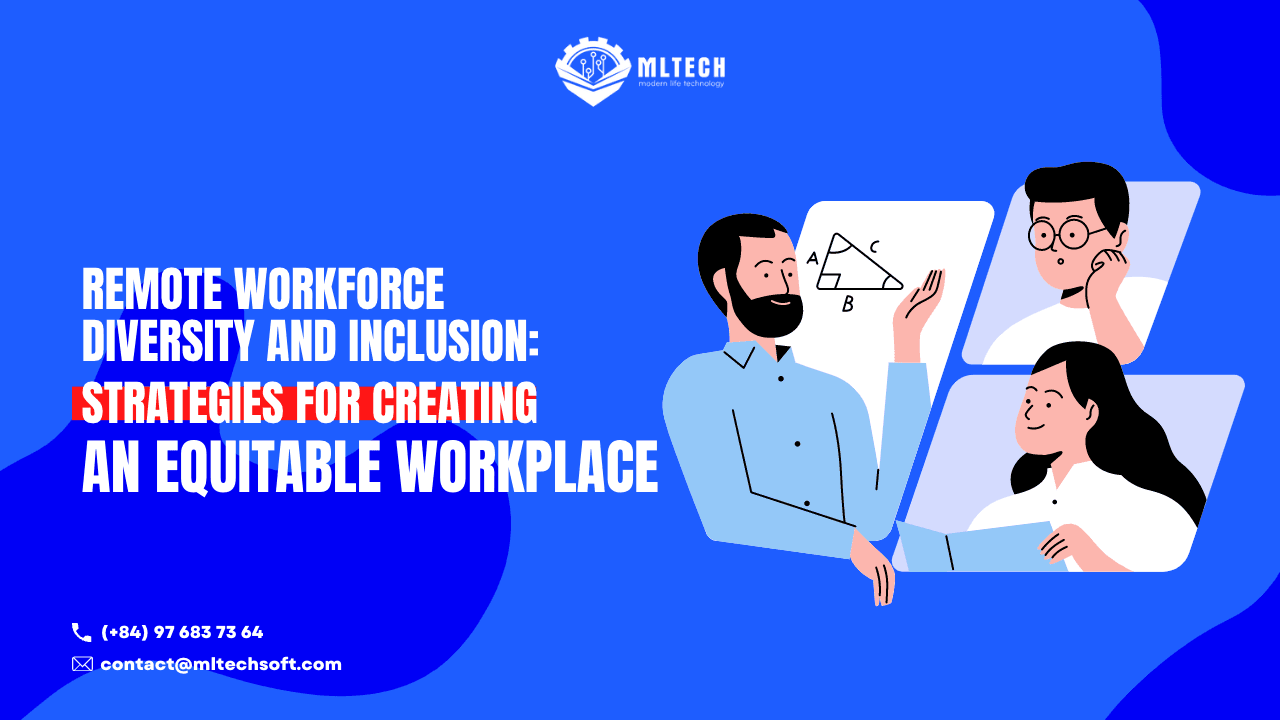Scroll down for more
Remote Workforce Diversity and Inclusion: Strategies for Creating an Equitable Workplace

The impact of a non-inclusive and non-diverse workplace is lurking.
Low employee engagement, high turnover, 'groupthink' and stifling innovation can have a serious impact on a company's long-term success. Without early intervention, these dynamics can propagate to remote environments.
On the other hand, remote work's increased connectivity and flexibility open up a whole new world of opportunities that promote inclusion and make sure everyone has the chance to do their best work and make a meaningful contribution to the organization.
A diverse and inclusive workplace is one where everyone feels equally involved and supported in all aspects of the workplace, regardless of who they are or what they do for the company. The "all areas" part is important.
1. Introduction: Why diversity and inclusion are important in a remote workforce
Is there diversity in hiring, departments, and leadership? Or are there workplaces where 50% of employees are women and 0% of managers are? But do they all work in the same department? These insightful questions demonstrate true diversity and inclusion in the workplace.
Research shows the many benefits of a diverse and inclusive workplace:
- Higher revenue growth
- Increased willingness to innovate
- Improved ability to recruit a diverse talent pool
- 5.4x higher employee retention rate
Inclusion at work is one of the most important keys to employee retention.
2. The Benefits of a Diverse and Inclusive Remote Workforce: Understanding the Business Case
The main business benefits of taking inclusion and diversity seriously are talent and corporate reputation.

Talent:
Psychological contract research shows that people want to work for employers with good hiring practices. They also want to feel valued in their work.
For an organization to be competitive, it needs everyone to do their best work. Employers are becoming more aware of how important it is to hire people with the skills and talents they need and keep them.
In addition to making sure employee practices are fair and right, it's important to create an open and inclusive workplace where everyone feels valued and everyone's contributions are valued and acknowledged.
Flexible working and the design of the workplace are also important parts of a diversity strategy and a way to attract and keep a diverse pool of talent.
Company Reputation:
Companies should think about their corporate responsibility (CR) when it comes to diversity, because social exclusion and low participation rates can hurt business markets and their growth. CR used to focus on environmental issues, but more and more employers are focusing on the big picture to attract and retain both customers and employees.
Improve business performance:
Openness to diversity expands access to the best talent. Inclusion enables effective engagement with talent. Equality enables fair outcomes. Together, they lead to increased innovation, creativity, productivity, reputation, engagement, and business performance.
3. Identifying Diversity and Inclusion Challenges in Remote Workforces
However, bringing together a diverse group of people can also present some challenges. Let's explore what it is and how to overcome it.
Communication problem:
Communication problems are very common in heterogeneous teams for many reasons.
There may be language barriers, different communication styles and preferences, or someone with hearing loss on your team. It is important to address these challenges before problems arise. For example, suppose there are generational differences in communication preferences. A younger team member prefers to use Slack to communicate; an older team member prefers using the phone.
Guidance on when and how to use each platform can greatly benefit both groups. For quick questions and informal communication, suggest Slack.

Or you may find that people who speak English as a second language or hearing-impaired people struggle to keep up with conversations in meetings. In this case, the meeting leader should remind participants to speak clearly and slowly, and each participant should feel comfortable asking for clarification if necessary.
Cultural misunderstanding:
Misunderstandings can occur when people from different cultures get together. For example, in some cultures, it is uncomfortable to use the thumb, use your left hand, or pat someone on the back.
By building an inclusive workplace, offended team members can see the misunderstandings as they are. If team members are confident that their differences are respected, they are more likely to agree with others when in doubt.
An inclusive workplace also creates an environment in which feedback and clarification are welcomed when team members say or act potentially offensively. Teaching moments help each team member do their part and create a more inclusive workplace. At the same time, broaden your knowledge and understanding of other cultures.
Slower decision-making:
Diverse perspectives, opinions, and ideas are great for innovation but can slow decision-making and achieving goals. For example, a team member challenging the status quo at a meeting may raise an important issue that requires investigation.
Create space by giving your team more time to explore different ideas, discuss them, and make more informed decisions. There are many benefits to allowing people to express themselves even outside their area of expertise.
However, there should always be a final decision-maker who can consider all ideas and ultimately decide how to proceed. In doing so, contributors should be acknowledged so that other team members feel valued for their ideas.
Unjustified inclusion:
An inclusive workplace can mean different things to everyone. For transgender team members, users can include places to add pronouns to their platform and gender-neutral bathrooms.
For veterans with PTSD, this could mean getting mental health benefits and being able to use flextime to see a therapist. It may also include flexible spending accounts for working parents to plan childcare and team-building events during working hours. So the workplace may feel inclusive to some. No, but it may not be for others.
Feedback from the team members should be the driving force behind an inclusive workplace, which is always a work in progress.
4. Building a Diverse and Inclusive Remote Workforce: Strategies for Recruitment and Hiring
This wide range of best practices and tips for hiring can help you build a reputation as an employer who welcomes everyone and gets the best people to work for you.
Set smart goals:
Whether you're looking to recruit for executive positions, recruit internally or externally, hire to address a shortage or overstaffing problem, or hire a boomerang employee, you should be clear about your all-inclusive recruiting goals...
Without a clear goal, it can be difficult to get where you want to be as an inclusive employer. This is probably one of the most important diversity hiring best practices.
Formulation of a diversity recruitment strategy:
Once you have established your SMART goals for inclusive hiring, you should develop a hiring strategy that guides the rest of your diversity hiring best practices across your organization. It serves as a roadmap to becoming a fairer and more diverse employer.
A diversity hiring strategy not only sets clear goals but also defines the actions you take, who is held accountable, and how success is measured. This is the basis for attracting, engaging, valuing, and recruiting different talents.
Promote your employer's brand:
You probably have had at least a few disgruntled employees over the years. To combat these potentially harmful reviews, it's important to work on improving your brand as an employer. Communicate your commitment to diversity and inclusion through as many channels as possible.
Post your initiative on social media to show potential candidates that you care about all employees. Create a culture that promotes work-life balance and helps employees reach the next career level. A strong company culture attracts talent and retains the best employees.

Create accessible websites:
Also, if you haven't already created an accessible website, you should do so. Use our website to promote your diversity and inclusion efforts.
Try to use comprehensive language and a wide variety of content types, such as videos and downloadable fact sheets. You can also use subtitles for your videos and audio files. A good standard is the Web Content Accessibility Guidelines (WCAG). These principles form the basis of accessibility on the Internet.
It's perceptible, operable, understandable, and robust.
Use different recruitment platforms:
When defining your diversity and inclusion hiring best practices, be sure to include an analysis of the hiring platform you're using. We automatically limit the variety of our audience by only using platforms that people in certain groups tend to use.
5. Inclusive Leadership in Remote Workforces: Fostering an Equitable and Supportive Culture
To provide an inclusive experience, here are five actionable steps to help foster a culture where all employees feel safe and welcome.
Question:
Collect feedback regularly and share results at the team level. When business leaders consistently accept constructive and positive feedback, it opens the door to real progress. But asking questions is not enough.
Leaders should not only directly ask employees what they need to feel included, but also act on that feedback. Taking the initiative to directly recognize how people are feeling and taking action to address identified issues is critical to making people feel heard and respected.
Approve:
In any organization, employees should feel free to ask questions, regardless of their title. To encourage this mindset, companies can provide training and education to encourage and embrace constructive disagreement. This allows everyone to feel supported by sharing their true perspective.

Integration:
Creating genuine connections between employees in the workplace is fundamental to an inclusive workplace. Giving employees the chance to build meaningful relationships at work makes them more loyal, which is a strong sign of productivity and seniority. Businesses should offer a variety of ways to connect, such as social clubs and events, to make everyone feel invited and truly welcome.
6. Addressing Unconscious Bias in Remote Workforces: Tools and Techniques for Promoting Fairness
Fairness and integrity include honesty, transparency, and consistent leadership. We make decisions that are fair and just, and we are humble enough to know that everyone has different strengths and weaknesses.
We value integrity, justice, and fair treatment in the workplace.
Ensure that all employees are treated with respect and dignity.
We don't allow discrimination or shaming, and the place where we work is safe and comfortable.
Think about how humility and openness can help people talk honestly about bias in the workplace and how to stop or get rid of it. At the same time, remember that everyone has their own biases.
Build trusting relationships with employees.
Make the health and happiness of your employees a top priority at work and create an atmosphere where people not only feel supported by management but are also encouraged to help each other.
Supports individual limitations by working as a cohesive group toward goals with a common focus. Ignoring restrictions does not increase work motivation.
Consider how you can improve the fairness and integrity of your company. Remember, there is always room for improvement.
7. Fostering Connection and Community in Remote Workforces: Building Relationships Across Differences
Emphasize clear communication:
It may seem obvious, but a focus on clear, ongoing communication is a surefire way to build a connected, remote team. As previously mentioned, 37% of teleworkers see collaboration and communication as major challenges.
Focus on mental health:
In other words, there is no one-size-fits-all solution. Some employees find remote work to be a huge mental health benefit, while others find it far more challenging.
One thing the majority of employees (74%) agree on is that companies should focus more on employee mental health and wellbeing. Unfortunately, only 55% of his employees feel the company cares about their mental health. These results send a clear message to employers.
Strengthen mental health and well-being support, especially for remote teams.

8. Measuring Success: Assessing the Impact of Diversity and Inclusion Initiatives in Remote Workforces
In a remote workplace, we miss those little moments that create human connections. This makes it difficult to identify those who may be feeling left out or disconnected from their team. Not everything, like cases of employment discrimination or burnout, is easy to see in remote places. So we need to be able to virtually reproduce organic interactions and check-ins.
It's also worth finding ways to encourage employees to network with different teams in the workplace. They may find people with more relatable traits and personalities to foster that sense of belonging
Be flexible and open-minded:
Employers who want to make their companies more diverse may find that remote work is a great way to do so, because it lets them find talent across borders. But can we reliably include people from different backgrounds and locations, and can everyone thrive in a remote environment?
9. Conclusion
As a business leader, think about the impact your voice has on your employees and use the right tone. You'll be amazed at the benefits this can bring to your business and bottom line.
Content
Get our blog
Want the latest and greatest from our blog straight to your inbox? Chunk us your details and get a sweet weekly email.
Read more in our blog

Project Management
The Impact of Dynamic Pricing on Customer BehaviorExplore the impact of dynamic pricing on customer behavior and learn how to implement effective pricing strategies.

Project Management
Focus in Scrum: Keeping Your Team on TrackDiscover effective strategies to maintain focus within your Scrum team, overcome common challenges, and boost productivity.

Project Management
Key Metrics for Mobile App SuccessDiscover the essential metrics for mobile app success, from user acquisition and engagement to monetization and performance.
MLTECH SOFT